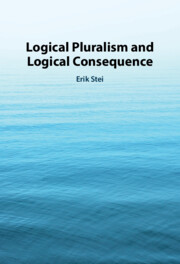Book contents
- Frontmatter
- Contents
- Figures
- Preface
- Chapter 1 Logical Pluralism Introduced
- Chapter 2 What Does It Mean for a Logic to Be Correct?
- Chapter 3 Three Dimensions of Plurality
- Chapter 4 The Cardinality of Logical Consequence
- Chapter 5 Domain Dependence
- Chapter 6 Pluralities of Meanings
- Chapter 7 Pluralism and Disagreement
- Chapter 8 Normativity and Collapse
- Chapter 9 Closing Remarks
- References
- Index
Chapter 2 - What Does It Mean for a Logic to Be Correct?
Published online by Cambridge University Press: 23 March 2023
- Frontmatter
- Contents
- Figures
- Preface
- Chapter 1 Logical Pluralism Introduced
- Chapter 2 What Does It Mean for a Logic to Be Correct?
- Chapter 3 Three Dimensions of Plurality
- Chapter 4 The Cardinality of Logical Consequence
- Chapter 5 Domain Dependence
- Chapter 6 Pluralities of Meanings
- Chapter 7 Pluralism and Disagreement
- Chapter 8 Normativity and Collapse
- Chapter 9 Closing Remarks
- References
- Index
Summary
This chapter explores a number of ways to understand the key notions of the plurality thesis. First, I disambiguate three readings of the term logic: (i) purely formal systems, (ii) interpreted logical theories, and (iii) the subject matter of logical theories. I argue that this distinction is relatively lightweight and should be acceptable on all prominent views about the nature of logical consequence. Building on those readings of logic, I then explore different conceptions of what it means for a logic to be correct. In particular, I present a generic view of correctness of logical theories which is broad enough not to exclude pluralists who claim that the plurality thesis should better be put in terms of the legitimacy or the usefulness of a logic. I propose different ways to strengthen the generic view by means of a weak or a strong version of the correspondence view or the logic-as-modeling view. Finally, I introduce different implementations of the plurality thesis resulting from the different readings of logic and of correctness and identify the interesting version of the thesis which will be the subject of the rest of the book.
Keywords
Information
- Type
- Chapter
- Information
- Logical Pluralism and Logical Consequence , pp. 12 - 36Publisher: Cambridge University PressPrint publication year: 2023
